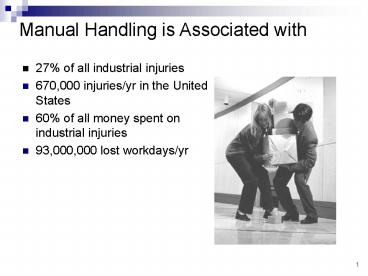Manual Handling is Associated with - PowerPoint PPT Presentation
Title:
Manual Handling is Associated with
Description:
Task Modifications ... RWL = LC HM VM DM FM AM CM. RWL = recommended weight limit ... FM = frequency multiplier. AM = asymmetry multiplier. CM ... – PowerPoint PPT presentation
Number of Views:124
Avg rating:3.0/5.0
Title: Manual Handling is Associated with
1
Manual Handling is Associated with
- 27 of all industrial injuries
- 670,000 injuries/yr in the United States
- 60 of all money spent on industrial injuries
- 93,000,000 lost workdays/yr
2
Approaches to Recommendations
- Biomechanical
- Physiological
- Psychophysical
3
Manual Handling Variables
- Individual
- Technique
- Task
4
Pushing and Pulling Strength Factors
- Handles
- One hand vs. two hands
- Body posture
- Application height
- Direction
5
Push/Pull Summary
- Two hands are usually better than one.
- Force capability goes down as it is exerted more
often. - Initial force capability is higher than sustained
capability. - Pushing capability is higher than pulling.
- Push at waist level pull at thigh level.
6
Task Modifications
- Measure the force required to move all wheeled
equipment periodically check the forces. - Install vertical push/pull bars on carts.
- Push rather than pull loads.
- Avoid muscle-powered pushing and pulling for
ramps, long distances, and frequent moves. - Use mechanical aids and momentum.
- Reduce force by reducing friction.
7
Holding
- Problems
- Holding gives a static load combining body weight
and object weight. - Low-back pain arises from spine biomechanics.
- Solutions
- Reduce the magnitude and duration of the torque.
- Use balancers.
- Limit high loads to short durations.
8
Carrying Guidelines
- Replace carrying with pushing or pulling.
- Minimize the moment arm of the load relative to
the spine. - Consider carrying large loads occasionally rather
than light loads often. - Use teamwork.
- Consider using balancers, manipulators,
conveyors, or robots. - Reduce lifting by raising the initial location.
- Avoid carrying objects up and down stairs.
9
Lifting Guidelines
- 51 lbs is the maximum that can be lifted or
lowered (load constant). - Recommended weight limit (RWL) is load constant
multiplied by various factors. - Lifting index
- load weight / RWL
10
NIOSH lifting example
- At initiation,
- Horizontal location, H1 10 in.
- Vertical location, V1 40 in.
- Vertical location, V2 51 in.
- Angle of asymmetry, A 0
- Frequency, F 12 /min.
- Load 14 lbs.
- Duration 2 hr.
- What is the RWL?
- What is the Lifting Index, LI?
11
Basic NIOSH Lifting Formula (pg. 269)
- RWL LC HM VM DM FM AM CM
- RWL recommended weight limit
- LC load constant (51 lbs.)
- HM horizontal multiplier
- VM vertical multiplier
- DM distance multiplier
- FM frequency multiplier
- AM asymmetry multiplier
- CM coupling multiplier
12
Multiplier Formulas
- Horizontal multiplier
- HM BIL / H
- BIL Body interference limit
- H Horizontal location
- Vertical multiplier
- VM 1 VC V KH
- VC Vertical constant
- 0.0075 for inches, 0.003 for cm.
- V Vertical location
- KH Knuckle height (assume 30 in.)
13
Multiplier Formulas (cont.)
- Distance multiplier
- DM .82 DC/D
- DC Distance constant
- 1.8 for inches, 4.5 for cm.
- D Vertical travel distance
- Asymmetry multiplier
- AM 1 .0032A
- A Angle of symmetry
14
Multiplier Formulas (cont.)
- Frequency multiplier
- See Table 15.9.
- Lifting frequency mean number of lifts in a
15-minute period - Lifting duration /session in hours may be
- Short .001 h to 1 h
- with recovery time of 1.2 duration
- Moderate gt1 h 2 h
- with recovery time of .3 duration
- Long gt2 h but 8 h
15
Multiplier Formulas (cont.)
- Coupling multiplier
- See Table 15.10, 15.11, Fig. 15.13
- Depends on
- Height of initial and final handcontainer
coupling - Whether coupling is good, fair, or poor
16
Force Limits
- FL A F DIST
- A Age factor
- F Frequency factor
- DIST Distance factor
- Differences between force limits and NIOSH
guidelines. - Different factors
- Different criteria
- FL permissible load 1.8 times that of NIOSH
17
Resources
- Manual Handing Guide (Mital et al.)
- Biomechanical software
- ErgoIntelligence MMH
- 2D Static Strength Prediction Program
- 3D Static Strength Prediction Program
18
Guidelines for Manual Handling
- Three categories
- Select individual
- Select strong people based on tests.
- Teach technique
- Bend the knees.
- Dont slip or jerk.
- Dont twist during the move.
- Design the job
- Use machines.
- Move small weights often.
- Get a good grip.
- Put a compact load in a convenient container.
- Keep the load close to the body.
- Work at knuckle height.
19
Examples to discuss































